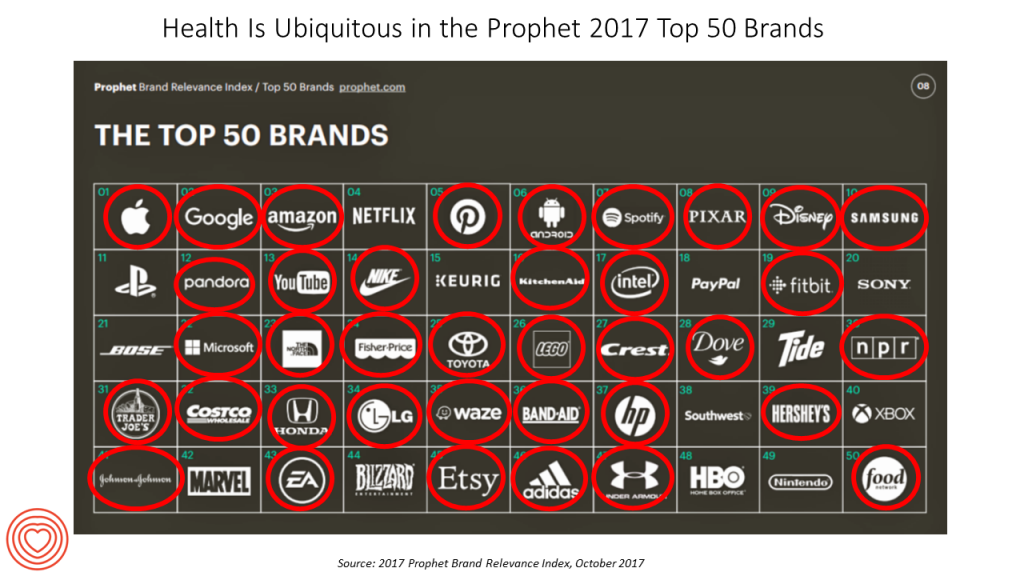 U.S. consumers’ most-valued brands include Apple, Google, Amazon, Netflix, Pinterest, Android, Spotify, PIXAR, Disney and Samsung, according to the 2017 Brand Relevance Index from Prophet. The top 50 are shown in the first chart.
U.S. consumers’ most-valued brands include Apple, Google, Amazon, Netflix, Pinterest, Android, Spotify, PIXAR, Disney and Samsung, according to the 2017 Brand Relevance Index from Prophet. The top 50 are shown in the first chart.
On the second chart, I’ve circled in red the brands that have reach into healthcare, health, fitness, and wellness. Arguably, I could have circled every brand in the top 50 because in one way or another, depending on the individual, people find health “everywhere” that’s relevant to them based on their own definitions and value-systems.
This is Prophet’s third year conducting this study, and I was keen to mine the health industry implications. I spent time on the phone with members of the team who work with the health industry and who have built this index from the beginning.

Prophet surveyed 13,500 U.S. consumers across 275 brands in 27 categories, using “4 Principles of Brand Relevance” in identifying consumers’ top relevant brands; they are,
- Customer obsessed (brands we can’t imagine living without)
- Ruthlessly pragmatic (brands we depend on)
- Distinctively inspired (brands that inspire us), and
- Pervasively innovative (brands that consistent innovate).
Traditional healthcare stakeholders – hospital systems, health plans, and insurers — don’t register highly in this study, Jeff Gourdji who leads health industry efforts at Prophet noted. This is because healthcare is generally a regional phenomenon. Thus, the “N” number of consumer respondents who named a particular healthcare organization is too small to compete with the likes of an Apple, Google, or Amazon.
Among all healthcare entities, the top-ranked brand this year was the Mayo Clinic. Other health system brands that bubbled up in the study included Cleveland Clinic, Northwestern Memorial, Dignity Health (which is a Health Populi brand favorite [not a client]), and Novant.
Health Populi’s Hot Points: There are indeed health/wellness/fitness brands in the Top 50, such as Crest (oral health), Dove (personal care), Fitbit (digital health), Under Armour (fitness and digital health), Nike (fitness), and adidas (fitness and digital health, and a client). Johnson & Johnson, #41 on the list, covers several segments in health and healthcare, including consumer/personal care, over-the-counter, medical devices, and pharmaceutical. J&J is the sole pharma in the Top 50, albeit probably not associated by consumers with the pharma aspects of the corporation. Note that Band-Aid, brand #36, is one of J&J’s consumer-facing products called out by consumers in the study.
There’s another lens through peoples’ “prismatic” perspectives on brands that suggest or enable health and wellness, Jesse Purewal, one of the innovators of this research, discussed. North Face’s branding invites us to never stop exploring, to be healthy living humans. Fitbit isn’t just a device but helps us achieve our personal goals. And, LEGO, I then riffed along, is one of my personal tools for mindfulness and fun – certainly health-building in the Kahn household of LEGOmaniacs.
Through my own Health-Is-Everywhere ecosystem perspective, I note in the second diagram just how many brands I see serving health and healthcare circled in red. Just ponder #1 Apple, #2 Google, #3 Amazon – three companies who have made significant health announcements in just the past few weeks. Others, like Samsung, Microsoft and SONY, are involved in health technology and medical devices. And in my expansive health/care-everywhere world, even Honda and Toyota, covered ten years ago here in Health Populi, are innovating in connected cars for the Internet-of-Health.
Many of my friends and colleagues would also name Hershey, brand #39, as a product for health when you just need that piece of dark chocolate to boost those flavonoids (which the Mayo Clinic discusses here).
Trader Joe’s, the top-ranked grocery brand in this study, can arguably through the lens of this health economist be a health destination for good food, sustainably sourced, at a good-value-for-money price, boosting financial wellness. This week, the Welltok consumer survey pointed out that financial stability is peoples’ top factor for health and wellness, further rationale for my assertion.
Patients, now health consumers, look to their favorite consumer-brands for health and wellbeing, along with value. Watch this space – it’s fast-growing and highly relevant to health consumers.
The post Health (Not Healthcare So Much) Abounds in Prophet’s Top 50 Brands appeared first on HealthPopuli.com.
Article source:Health Populi
No comments:
Post a Comment